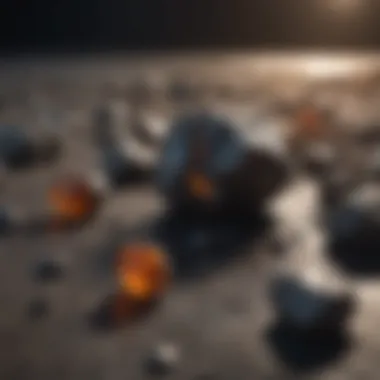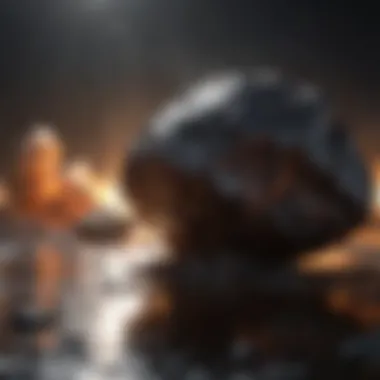Testing a Meteorite: Methods and Significance


Intro
In the realm of natural history, meteorites stand out as significant objects of study and fascination. They are remnants of celestial bodies that have survived their passage through Earth's atmosphere. Understanding meteorites is not just about identifying pieces of rock from space but about unraveling their complex history, significance, and classification. This article aims to provide a deeper understanding of the process involved in testing meteorites.
History and Origins
Meteorites have intrigued humanity since ancient times. Each piece holds stories of cosmic events, potential origins from asteroids or the Moon, and even planets like Mars. The impact of meteorites on society and culture is profound. From ancient civilizations attributing divine significance to these celestial stones, to modern scientific advances, meteorites are more than mere rocks; they are insights into the universe.
Overview of Collectibles, Rocks, and Fossils
Meteorite collectors often blur the line between geology and astronomy. These enthusiasts find joy in gathering unique specimens, ranging from ordinary stones to rarities. Each collection piece can be tied to specific events such as meteor showers or distinct locations. The collecting of meteorites has gained traction over decades, with communities emerging around this niche interest. Collecting combines the thrill of discovery with a chance to own a piece of the cosmos.
Historical Significance and Cultural Impact
Throughout history, meteorites have been revered as omens or signs from the heavens. The famous Sikhote-Alin meteorite, which fell in Russia in 1947, attracted government attention and public curiosity alike. Throughout time, various cultures revered meteorites, incorporating them into their lore and rituals. Understanding this cultural context enhances appreciation for these celestial gifts, showcasing their role beyond mere scientific study.
Identification and Classification
Identifying meteorites is essential for both collectors and scientists. This discipline involves meticulous analysis, distinguishing true meteorites from terrestrial rocks. Knowing how to recognize a meteorite allows collectors to appreciate their finds fully.
Guide to Identifying Rocks and Fossils
Several key features can help identify meteorites:
- Fusion crust: A thin black exterior from intense heat during atmospheric entry.
- Widmanstätten patterns: Unique internal structures visible in certain iron meteorites.
- Density and weight: Meteorites tend to be denser than typical Earth rocks.
- Magnetic properties: Many meteorites possess magnetic characteristics due to iron content.
Common Types and Variations
Meteorites are classified into three primary types:
- Stony Meteorites: The most common type, consisting mainly of silicate minerals.
- Iron Meteorites: Composed predominantly of iron and nickel, these meteorites reveal information about the core of asteroids.
- Stony-Iron Meteorites: A hybrid type that features both metallic and rocky components.
Each classification has its variations, revealing distinct characteristics and formations. Understanding these differences enhances the knowledge and appreciation for meteorites in collections.
"Meteorites provide a window into the solar system's history, and their study has implications for both scientific knowledge and cultural legacy."
The detailed examination of meteorites enriches scientific discourse and informs collectors about the significance of their acquisitions. The exploration of testing methods, collections, and cultural impacts creates a robust framework for understanding meteorites in our world.
Understanding Meteorites
In the realm of planetary science and natural history, meteorites hold significant importance. These celestial fragments provide invaluable insights into the formation and evolution of our solar system. Understanding meteorites is essential, as it encompasses their properties, classifications, and the methods used for testing. By delving into this topic, readers gain a foundation for appreciating both the scientific and cultural relevance of meteorites. This section highlights key elements, benefits, and considerations surrounding meteorites, aiming to enhance the reader’s knowledge.
Definition and Origin
Meteorites are remnants of meteoroids that survive their fiery journey through Earth's atmosphere and impact the surface. These objects can originate from asteroids, comets, or even other celestial bodies like the Moon and Mars. By studying meteorites, scientists can uncover details concerning the early solar system, including the processes that led to planet formation. Understanding both the definition and origin of meteorites is crucial for recognizing their role in research and collection activities.
Types of Meteorites
Meteorites are classified into three primary types: Stony Meteorites, Metallic Meteorites, and Stony-Iron Meteorites. Each type possesses distinct characteristics and contributes uniquely to the overall study of meteorites.
Stony Meteorites
Stony meteorites are the most common type, making up about 94% of all known meteorite samples. Composed primarily of silicate minerals, they offer critical information about the composition of the early solar system. The key characteristic of stony meteorites is their varied mineralogy, which can reflect the processes that led to their formation. Their popularity stems from their abundance and the wealth of data they provide. However, a unique feature of stony meteorites is their susceptibility to weathering. This can sometimes obscure vital information necessary for detailed analysis, but their diverse compositions often counterbalance this drawback.
Metallic Meteorites
Metallic meteorites are primarily composed of iron and nickel, making them less common, yet significant for scientific study. The unique aspect of metallic meteorites lies in their crystalline structures. These structures can provide insight into the cooling history of the metal in space. They are often valued for their aesthetic appeal in collections. On the downside, identifying metallic meteorites can be challenging, requiring careful testing to confirm their status. Nonetheless, their rarity and unique properties make them a fascinating subject in meteorite research.
Stony-Iron Meteorites
Stony-Iron meteorites, as the name suggests, consist of a mixture of silicate minerals and metallic elements. They are particularly interesting because they represent a transitional type between stony and metallic meteorites. The combination of both components allows them to provide a glimpse into the processes occurring in differentiated asteroids. Their key characteristic is the presence of both mineral and metal, offering a unique opportunity for analysis. While less abundant than the other types, their diverse properties make them essential for understanding planetary processes, including differentiation and cooling. With their intriguing composition, they stand out as a distinctive choice for both collectors and researchers.
Meteorites not only connect us to the cosmos but also enhance our understanding of Earth's history.
Through these classifications, the testing of meteorites reveals much about their origins and histories. Understanding the different types helps in selecting appropriate testing methods and appreciating the value each type holds in both scientific investigation and personal collections.
Importance of Testing Meteorites
Meteorite testing is crucial for various reasons that span scientific inquiry, classification, and valuation. Understanding the importance of testing meteorites helps collectors appreciate the knowledge that can be acquired through different methods. Testing not only reveals the meteorite's origin but also contributes to our understanding of the early solar system.
Scientific Significance


The scientific significance of testing meteorites cannot be understated. Each meteorite holds a unique story of cosmic history, often containing primordial materials that predate Earth itself. Analyzing these samples through various methods enhances our understanding of planetary formation and the evolution of celestial bodies. For example, isotopic analysis can reveal the age of a meteorite, which is essential for establishing timelines in solar system history.
Through techniques like spectroscopy and X-ray diffraction, scientists can determine mineral compositions and elemental structures. This research leads to breakthroughs in fields such as geology, astronomy, and physics. The data retrieved from meteorites can inform theories about the conditions in which they formed, shedding light on processes which shaped our galaxy.
Collecting and Valuation
For collectors, the testing of meteorites also impacts how they are valued. Collectors often seek out meteorites not just for their aesthetic appeal but for their scientific value as well. A meteorite with a well-documented provenance and testing history can fetch significantly higher prices.
Moreover, understanding the classifications, such as stony or metallic meteorites, helps collectors make informed decisions about their purchases. Valuation may depend on rarity, size, and specific characteristics such as the presence of unique minerals. Testing provides assurance that the specimen is genuine, increasing its market value and appeal.
- Factors that influence collecting and valuation include:
- Provenance history
- Scientific significance
- Rarity of the meteorite type
In summary, testing not only serves to unlock the mysteries of the cosmos but is also an invaluable element for collectors who wish to invest wisely in their collections. A meteorite’s physical and chemical properties, coupled with scientific analysis, allow for a nuanced understanding that enhances both appreciation and valuation in this captivating field of natural history.
Basic Testing Procedures
Basic testing procedures form the foundation of meteorite analysis, allowing collectors and researchers to ascertain the authenticity and nature of their specimens. These steps are crucial for differentiating between genuine meteorites and terrestrial rocks, thereby influencing subsequent testing and evaluation methods. The importance of fundamental testing cannot be overstated; it establishes a basis for the more advanced analyses that often follow.
Visual Inspections
Visual inspection is typically the first step in the testing process. This method involves assessing the physical characteristics of a meteorite, such as its size, shape, and surface texture. Collectors should be familiar with common features that distinguish meteorites from ordinary earth rocks. For instance, the presence of fusion crust, a thin, glassy exterior formed during atmospheric entry, is a strong indicator of meteorite origin.
Common visual traits to look for include:
- Regmaglypts: These are thumbprint-like impressions in the meteorite's surface, created by the intense heat during entry.
- Color: While earth rocks often have dull colors, many meteorites have a metallic sheen due to their mineral content.
- Inclusions: Tiny metallic grains or chondrules can often be spotted in stony meteorites.
A careful visual examination helps in establishing initial classifications, supporting further inquiries into the meteorite’s history and composition.
Magnetic Testing
Magnetic testing stands as a valuable procedure in the toolkit of meteorite classification. This method capitalizes on the presence of metallic iron in many meteorites, allowing collectors to determine their authenticity. A simple household magnet can suffice for this test; if the specimen is attracted to the magnet, it may contain significant metal, which is typical for certain types of meteorites.
Points to consider in magnetic testing include:
- Intensity of magnetism: Not all meteorites respond equally. The presence of metallic minerals can vary based on the meteorite type.
- Comparison with terrestrial rocks: Many ordinary terrestrial rocks may have low magnetic properties. Identifying differences can help avoid misidentification.
- Subsequent tests: A positive magnetic response can guide collectors toward more sophisticated techniques, confirming findings or leading to new classifications.
"Basic tests such as visual inspections and magnetic testing are critical for those new to meteorite collecting. These methods lay the groundwork for deeper analyses that can illuminate a specimen’s cosmic journey."
In summary, engaging in basic testing procedures such as visual inspections and magnetic testing aids meteorite enthusiasts in making informed decisions. These preliminary methods are straightforward yet essential, setting the stage for more elaborate investigations into the fascinating world of meteorites.
Advanced Testing Techniques
Advanced testing techniques are vital for gaining a comprehensive understanding of meteorites. These methods provide insights that basic tests cannot offer. They reveal the mineralogical, chemical, and structural composition of meteorites. Because of their complexity and specificity, these tests enable scientists and collectors to classify meteorites accurately and to uncover their history in the solar system.
Spectroscopy
Spectroscopy is a powerful tool in meteorite analysis. This method involves studying the light spectrum emitted or absorbed by a sample. Different elements and compounds absorb and emit light in unique ways, leading to characteristic spectra. Scientists utilize spectroscopy to identify mineral compositions in meteorites. Techniques such as infrared and Raman spectroscopy are particularly useful in characterizing organic compounds and minerals within these celestial rocks.
Applications of spectroscopy in meteorite testing include:
- Determining elemental and molecular composition.
- Identifying specific minerals that reveal the meteorite's origin.
- Providing information on thermal history and alteration processes.
X-Ray Diffraction
X-ray diffraction, or XRD, is another crucial technique for analyzing mineral structures in meteorites. This method works by directing X-rays at a sample and measuring the angles and intensities of the rays that are scattered by the atoms in the material. The resulting diffraction pattern can be analyzed to determine crystalline structure and phase identification.
Key points regarding X-ray diffraction include:
- It helps in distinguishing between similar minerals by their crystalline structure.
- XRD can determine the abundance of specific minerals, critical for classification.
- It offers insights into the thermal and pressure conditions under which the meteorite formed.
Microprobe Analysis
Microprobe analysis is an advanced method for obtaining information on the elemental composition of meteorites at a microscale. It uses electron beams to excite atoms in a sample, allowing precise measurements of elemental distribution and concentration. This technique is essential for detailed geochemical analysis, particularly in understanding the history and evolution of meteorites.
Benefits of microprobe analysis include:
- High spatial resolution that allows analysis of small areas within a meteorite.
- Quantitative measurements of trace elements, which can be important for classification.
- The ability to identify zonation and compositional changes within mineral grains.
Each of these advanced testing techniques contributes uniquely to our understanding of meteorites, informing both scientific research and collector interests. Their integration into testing protocols enhances our ability to discern the intricate histories that these ancient celestial rocks carry.
Sample Preparation Techniques
Sample preparation is a crucial step in the process of meteorite testing. This phase establishes the groundwork for the analyses that follow. Properly prepared samples ensure that the testing results are accurate and reliable. Inadequate preparation can result in misleading data, which may impact the interpretation of a meteorite’s properties and origins. Thus, these techniques play a significant role in providing valuable insights about the meteorite under study.
The process of sample preparation typically involves several distinct steps. Each step must be performed with care to maintain the integrity of the sample. The specific techniques used can depend on the intended analysis and the characteristics of the meteorite itself.


Cutting and Polishing
Cutting and polishing are foundational techniques in meteorite sample preparation. Most meteorites are irregularly shaped, making them difficult to analyze in their raw form. Cutting allows scientists and collectors to create flat surfaces that provide a clear view of the meteorite’s internal features.
The cutting process often uses diamond-tipped saws or specialized equipment designed for precision. These tools minimize damage to the sample during the cutting process. Once cut, the surface of the meteorite can be polished. Polishing involves using fine abrasives to create a smooth finish. This step not only enhances visual appeal but also facilitates the study of crystal structures and mineral compositions under a microscope.
Some key benefits of these techniques are:
- Enhanced visibility of internal features
- Improved surface quality for further analyses
- Easier handling during testing
Considerations must also be taken for cutting and polishing. It's important to avoid overheating the sample, which can alter its properties. Thus, wet cutting methods are often preferred.
Mounting for Analysis
The process of mounting for analysis is a subsequent, yet critical, step after cutting and polishing. Proper mounting ensures that the meteorite sample remains stable during testing. A well-mounted sample can significantly affect measurement accuracy in techniques such as spectroscopy or X-ray diffraction.
Several adhesives and methods can be used for mounting, depending on the analytical technique. For example, epoxy resins are commonly favorable due to their durability and transparency. Before mounting, the polished sample is usually treated to prevent contamination, which can skew results.
Some aspects to consider when mounting include:
- Choice of mounting material: Some materials may react with the meteorite.
- Positioning of the sample: The orientation can affect the results obtained during analysis.
- Thickness of the slice: For certain techniques, the thickness must be uniform.
Proper sample preparation is indispensable for accurate meteorite analysis.
Chemical Properties of Meteorites
Understanding the chemical properties of meteorites is essential for several reasons. The analysis of their elemental and isotopic composition reveals key information about their origin, formation, and even the processes that created our solar system. Furthermore, these chemical properties help in classifying meteorites, assessing their value, and understanding their historical significance. For collectors and researchers alike, recognizing the significance of these chemical attributes enables a deeper appreciation of their specimens and contributes to the broader scientific dialogue concerning planetary materials.
Elemental Composition
The elemental composition of a meteorite provides a window into its physical and chemical history. This composition typically includes common elements such as silicon, oxygen, iron, and magnesium. A careful analysis of these elements can identify whether a meteorite is stony, metallic, or stony-iron.
For example, stony meteorites often contain silicate minerals rich in silicate ions. In contrast, metallic meteorites primarily consist of iron and nickel. Stony-iron meteorites possess a mix of metallic and silicate components.
Some key points regarding elemental composition include:
- Identification of Meteorite Type: Different types of meteorites have distinct elemental profiles.
- Insight into Asteroid Composition: Elemental analysis provides information about the bodies from which the meteorites originated, often shedding light on asteroid compositions.
- Clues to Formation Processes: Variations in elemental ratios can indicate the environment in which the meteorite formed, such as differentiation events or impact processes.
"Understanding the elemental makeup of meteorites reveals the chemical fingerprints of their cosmic origins."
Knowledge of elemental composition is valuable not only for research purposes but also for collectors. A meteorite with a rare elemental profile might hold greater interest and value.
Isotope Analysis
Isotope analysis takes the exploration of meteorites a step further by examining the isotopic ratios of elements found within the sample. Elements such as oxygen, nitrogen, and carbon often exhibit varying isotopic compositions based on their origins and the processes they have undergone. This analysis can yield important insights into the age and formation conditions of meteorites.
For instance, isotopic ratios can reveal:
- Age of the Meteorite: Certain isotopes decay at known rates. Measuring these can provide dates for when the meteorite was formed.
- Thermal History: If a meteorite experienced significant heating, it might exhibit different isotope ratios indicative of that change.
- Source Material Analysis: Comparing isotopic compositions can connect individual meteorites to specific cosmic events or bodies.
The complexities of isotopic variations aid in constructing a narrative of the meteorite's journey through space and time. For collectors, understanding isotope analysis enhances their ability to appreciate the uniqueness of each specimen and explore its connection to the universe.
Analyzing both elemental compositions and isotopic make-up ultimately contributes to a broader understanding of meteoritics, an essential area of study for both science and collectors alike.
Physical Properties and Classification
Understanding the physical properties of meteorites is essential for their classification and analysis. Physical properties provide insight into the material's history, formation, and potential origins. Each meteorite exhibits unique characteristics that can help differentiate it from others and identify its type.
Through classification, scientists can categorize meteorites based on several factors, including density, hardness, weathering, and alteration. Each aspect plays a crucial role in the broader context of meteorite studies, ensuring that collectors and researchers have a clear understanding of what they are dealing with.
Density and Hardness
Density serves as a fundamental metric in the classification of meteorites. It informs about the meteorite's composition, as variations in density often indicate different material properties. For example, metallic meteorites, composed largely of iron, generally have higher density compared to stony meteorites, which are lighter.
The measurement of density is typically done by calculating the ratio of mass to volume. This is particularly significant when evaluating the authenticity of the specimen. Inconsistencies in expected density may suggest that a meteorite is a terrestrial rock rather than a space rock.
Hardness is also an important property, commonly assessed using the Mohs scale. This scale ranges from one to ten, with talc rated as one and diamond as ten. Meteorites usually fall between three to six on this scale, influencing how they are processed and displayed. Hardness can also provide clues about the meteorite's exposure to environmental conditions over time.
Weathering and Alteration
Weathering processes dramatically affect the appearance and integrity of meteorites. Exposure to the Earth's atmosphere leads to changes in texture and color, which can complicate their classification. For instance, surface rust and patinas may develop on metallic meteorites, shifting their visual presentation.


Meteorites from different regions may exhibit varying degrees of weathering. Those found in arid climates may retain more features compared to those discovered in humid areas. Identification requires careful consideration of these changes, as they may mask key characteristics that are important for proper classification.
Alteration may also occur due to interactions with minerals and elements in their surroundings. This aspect can lead to the formation of secondary minerals, which not only alters the meteorite but also informs its history and the environment it has been subjected to.
The analysis of physical properties like density, hardness, weathering, and alteration is pivotal in the quest to understand meteorites more fully. Each factor contributes to a larger narrative, guiding collectors and researchers alike in their endeavors.
History of Meteorite Study
Understanding the history of meteorite study is crucial for comprehending how scientific knowledge has evolved over time. This section sheds light on the transitions from early beliefs to modern scientific approaches in meteorite examination. It highlights the cultural impacts of meteorites on human knowledge and exploration. Additionally, it draws connections between historical context and modern techniques, allowing enthusiasts and collectors to appreciate the legacy of meteorite study.
Early Discoveries
Meteorites have fascinated humanity for centuries. The first recorded meteorite fall occurred in 1492, with a significant meteorite landing in the region of Ensisheim, France. This event sparked curiosity among scholars and the public alike. People believed these stones were celestial messages or omens from gods.
In the subsequent centuries, various civilizations documented meteorite findings. For instance, the ancient Egyptians used meteorite iron to create tools and ornaments, unknowingly utilizing materials from space.
A significant turning point in understanding meteorites came in the 18th century, particularly with the work of the scientist Ernst Florens Chladni. In 1794, he published a treatise that inspired rigorous examination of these objects, establishing the foundation for meteorite classification. Early studies relied heavily on visual inspections, which, while insightful, lacked modern scientific rigor.
Modern Advances
With the advent of advanced technology and new scientific methods, the study of meteorites entered a new phase in the 20th century. Techniques such as spectroscopy and isotopic analysis enabled researchers to unveil the complex histories of these celestial rocks. Modern meteorite research focuses on extensive classification systems that detail elemental composition and origin.
Today, collaborations between amateur collectors and professional scientists play an integral role in advancing knowledge in the field. Organizations like the MetSoc and databases such as the Meteoritical Society provide platforms for reporting and sharing meteorite finds. It proves how interconnected the community of collectors and researchers has become.
"The study of meteorites is not just about collecting rocks; it is about exploring the history of our solar system."
In summary, the journey from ancient beliefs to scientific discovery in meteorite studies illustrates the evolution of human understanding of our universe. Each meteorite serves not just as a specimen but as a time capsule, revealing secrets of our solar system's formation and history.
Resources for Collectors
The exploration of meteorites does not end with testing and analysis. For collectors, having access to the right resources can significantly influence their understanding and appreciation of these cosmic treasures. This section aims to shed light on why proper resources are essential, highlighting specific tools and information that can empower collectors in their journey.
One key element is the availability of recommended reading materials. Books and research papers can offer insights into the classification, history, and testing techniques of meteorites. Understanding this subject matter enhances collectors' knowledge, leading to more informed decisions when acquiring new pieces. Collectors can gain awareness of valuable information that often lies within the pages of well-researched publications.
Another crucial aspect is being a part of online communities. These platforms allow collectors to interact, share experiences, and obtain advice from more seasoned individuals. Engaging with others who share similar interests can provide invaluable insights and foster connections.
In summary, resources for collectors in the meteorite field offer a wealth of information and networking opportunities. By exploring reading materials and engaging with online communities, collectors can deepen their knowledge, improve their collecting skills, and appreciate the beauty of meteorites on a larger scale.
Recommended Reading
In the world of meteorite collecting, literature plays a vital role. Books such as "Meteorites: A Global Survey" by Janice Bishop provide an essential understanding of meteorite types and identification. Other notable mentions include:
- "The Book of Meteorites" by John G. Burke, which explores the physical properties and significance of various samples.
- "Meteors, Meteoroids, and Meteoritics" by David A. Krinsley focuses on meteorite classification and impacts.
These books serve not only as guides but also spark a deeper interest in the field. Academic articles from sources like Encyclopedia Britannica can also be invaluable for those seeking in-depth knowledge about meteorite science and proposals.
Online Communities
Connecting with other collectors can greatly enhance the meteorite collecting experience. Platforms like Reddit and Facebook host several groups dedicated to meteorites where enthusiasts discuss topics ranging from identification to valuation. Participation in these communities can introduce collectors to:
- Expertise Sharing: Learn from knowledgeable members who can provide insights and guidance.
- Market Trends: Stay informed about the latest trends in meteorite collecting and pricing.
- Events and Meet-Ups: Discover opportunities for local or online events where collectors can exchange knowledge or even trade samples.
Online communities are essential for fostering relationships and expanding knowledge. Having access to different perspectives can boost confidence in making purchasing decisions and evaluating meteorites.
"Knowledge increases by sharing, and the rich experience of those who have deeper insights enrich every collector's journey."
Whether through reading about meteorites or engaging in meaningful discussions online, these resources provide tremendous value to both new and experienced collectors.
Ethical Considerations in Meteorite Testing
In the realm of meteorite testing, ethical considerations play a crucial role that extends beyond mere scientific inquiry. These considerations influence how meteorites are collected, studied, and preserved. As the field evolves, understanding these aspects becomes increasingly important for collectors and scientists alike.
Preservation of Natural Resources
The preservation of natural resources is a primary ethical concern in meteorite testing. When a meteorite lands on Earth, it carries not only its intrinsic scientific value but also the imprint of our natural history. Collectors and researchers must balance their quest for knowledge with the obligation to protect these celestial remnants. The indiscriminate collection of meteorites can lead to the loss of important geological and historical data relating to both the meteorite and its surrounding environment.
Collectors are encouraged to prioritize sustainable practices. This means being mindful of the environmental impact of their activities. For example, gathering meteorites from protected areas or sites of scientific importance can compromise future research opportunities. Sustainable collecting involves ensuring that any action taken does not disturb the surrounding ecosystem. Practicing responsible collecting can lead to informing others and fostering a culture of environmental stewardship.
"Meteorites are not just objects of study; they are records of our cosmic past that must be preserved for future generations."
Legal Aspects of Collecting
The legal framework governing meteorite collection varies significantly across different regions. It is essential for collectors to be aware of the laws applicable to their areas. Collecting meteorites without requisite permits or from restricted locations can lead to severe penalties. Legal aspects contribute not only to the individual collector's responsibilities but also to the broader context of environmental ethics.
In many countries, legal statutes protect meteorites as valuable scientific specimens. This includes regulations that prohibit collecting meteorites from federal lands without appropriate permission. Such rules establish a protocol for ethical interactions with these natural resources.
Additionally, understanding the provenance of a meteorite is critical. Buying or selling meteorites whose origins are unclear can raise ethical questions. This can affect not only the integrity of the collection but also the potential for illegal trade. Collectors should seek to acquire meteorites through established channels that ensure compliance with relevant laws.
In summary, ethical considerations in meteorite testing shape the practices of collectors and researchers. A commitment to preservation of natural resources and adherence to legal frameworks fosters a responsible approach to meteorite collection and ensures that these celestial artifacts are respected and valued.



